| Kingsley House Established 1896 A beacon of hope for New Orleans families |
| The idea for Kingsley House began with, as one newspaper article referred to her, "a noble woman," by the name of Mrs. Peter Anderson, in 1896. Kingsley House steadily expanded under the guidance of Mrs. Anderson, Dr. Beverly Warner, the pastor of Trinity Episcopal Church, other early leaders of the movement, and with the help of the Episcopalian Diocese. When Eleanor McMain, one of the guiding lights of Kingsley House in its formative years, came aboard, she pushed for it to become a non-sectarian organization with an ecumenical board. In 1900, Kingsley House moved from its first home on Tchoupitoulas Street to larger quarters on Annunciation Street, where it remained for 25 years. In 1925, Mr. and Mrs. Frank B. Williams donated 3 acres of land at Constance and Richard Streets in the Lower Garden District, along with buildings and $300,000 toward construction costs, to Kingsley House. Over the years, there have been many addtions and renovations. Today, its campus is a peaceful and inviting sanctuary in the heart of the city. More than 120 years after its founding, Kingsley House continues to serve the community, far beyond the dreams of Mrs. Anderson, Rev. Warner, Ms. McMain and other settlement house pioneers of their day. Kingsley House stands as a tribute to its staff members, volunteers and to the people of New Orleans for their faithful support. -- Nancy |
| Did you know? That NORD is a descendant of the early sports programs that Kingsley House pioneered? That the Lighthouse for the Blind evolved from Kingsley House? That Tulane's School of Social Work had its beginnings in Kingsley House's programs? That Kingsley House helped wipe out yellow fever by spearheading efforts to screen windows/cisterns? That Kingsley House helped pass a child labor law? |

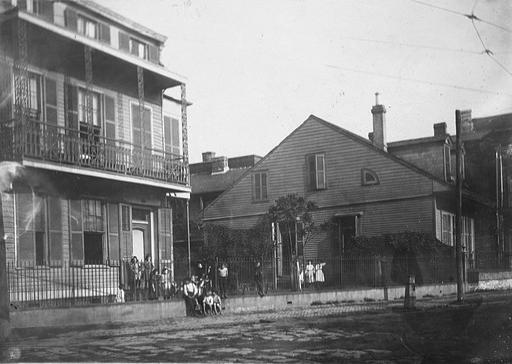
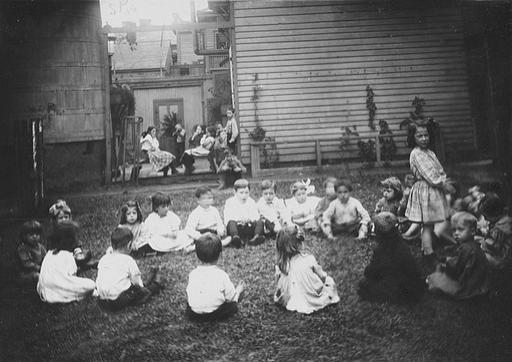
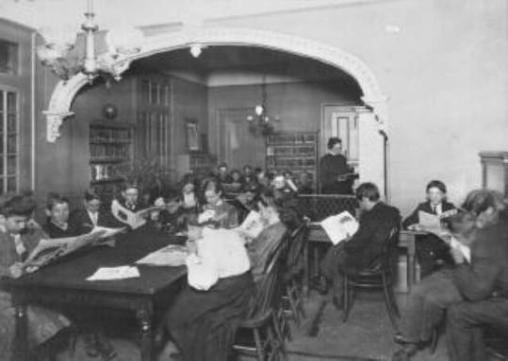
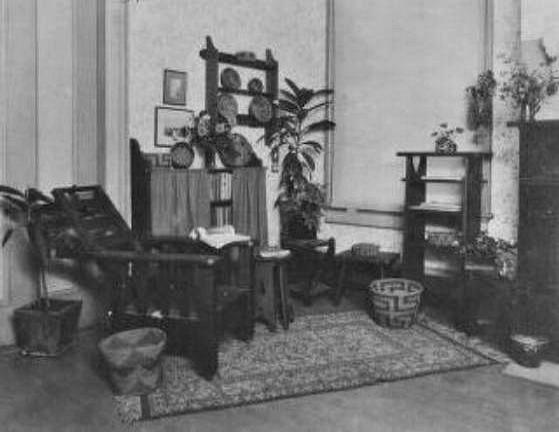
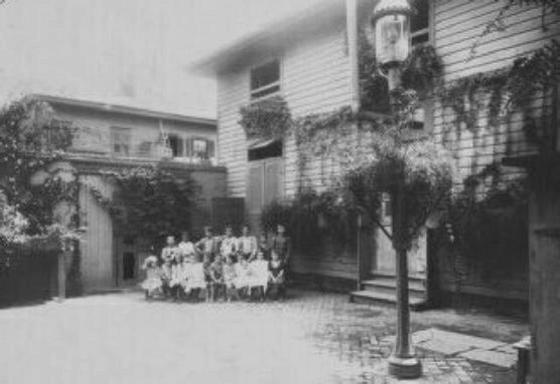
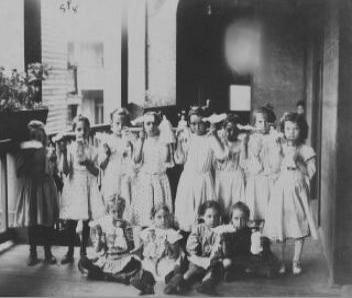

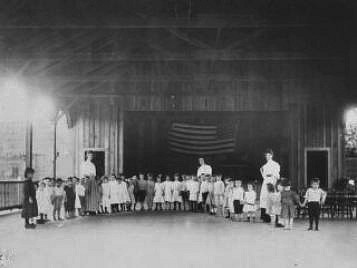
| Kingsley House's website The link to this page is: http://old-new-orleans.com/NO_Kingsley_House.html Back to Old New Orleans Whispers - Home |
| Above, Kingsley House, ca. 1900; showing their second home on Annunciation Street. I wasn't sure if this was the old site on Tchoupitoulas or the later location on Annunciation until Benjamin Castrillo did some research and found that the above photo is, indeed, from Annunciation Street. He, also, provided some interesting newspaper articles, which I've transcribed and placed at the bottom of the page. Many thanks to Mr. Castrillo for sharing. -- Nancy |
| From The Daily Picayune, December, 1896: A Christmas Tree at Kingsley House Makes timely a review of the noble work which real Christians are doing for boys and girls who have not their own advantages in life. Part of comprehensive up-building fostered by the Episcopal Church. Out in Tchoupitoulas Street, near the corner of Delord, stands a large brick building differing little in appearance from the long row of brick stores in the same square. It was more than five years ago that the ladies diocesan mission determined to found in this locality a free kindergarten mission school, and the row 928 was selected as the site. The school was opened every day except Saturday, and a noble woman, Mrs. Peter Anderson, feeling that much was being done for the girls, set to work to do something for the boys in the vicinity of the mission, who were growing up without the advantages of schooling or manual training. She spoke to the ladies of the mission, and they kindly allowed her the use of the rooms on Saturday to found a boys' club, the object of which should be the uplifting and assisting of the boys around. The club was founded and a committee, of which Mrs. Anderson was chairman, was formed to attend to its workings. Believing that the training of the heart and hand is the best way to reach the keynote of what is best in boy nature, the first work of the club was to establish a manual training school, a mechanical drawing class and a reading room, where the boys could gather, with the aim of lifting them out of the dull and often degraded life in which they were born, with no apparent chance of anything better, and give them not only some pleasure in life, but such instructions as might redeem them from idleness and teach them useful occupations. In the ground floor of the house, Mrs. Anderson and her committee decided to hold the reunions of the club; in the second floor, they furnished a room for the purpose of teaching the boys clay modeling, and Miss M. A. Thursdton, a graduate of the Sophie Newcomb College modeling class, was placed in charge. In the third floor, the ladies established a regular carpenter shop, purchasing all the tools for the boys and furnishing the lumber and the teacher for this manual training. Prof. W. E. Gregory, of Tulane University manual training school, was permitted, through the courtesy of the Tulane faculty, to undertake the instruction of the boys, and when it is said that the class averaged on the whole ninety students a year, an idea of the good accomplished might be gained. Miss Thurston also engaged to teach the boys mechanical drawing, and from 9 o'clock to 10 every Saturday, she is at her post, and the excellent results are apparent from the specimens displayed in this department. The entire furnishings of the rooms was done by Mrs. Anderson's committee. As the years went on, members of the committee dropped out of the ranks for various causes, but Mrs. Anderson always remained at the helm, supplying the places of those whose duty compelled them to give up the work as fast as a vacancy occurred in the ranks. The work was growing and growing beyond the expectations of the small band of earnest women who inaugurated it. The free mechanical drawing classes, clay modeling and manual training school averaged at least eighty pupils a night, and Mrs. Anderson determined to bring into the work the strong influence of some godly man, whose own personality would be an inspiration to the boys. It was about this time that the Trinity Church industrial aid fund had been started by Rev. Beverley Warner, that practical philanthropist, whose earnest work is being felt in many lowly and abandoned quarters of New Orleans. It was just one year ago that Mr. Warner appealed for funds to carry on the work of making Christianity a practical demonstration beyond the borders of his own parish. The funds came in generously and the wood yard was established, with the purposes of trying to help poor men to help themselves, enabling men to tide over difficult periods and keep their self-respect. Through the industrial aid fund, a creche was established, but it speedily outgrew both the means and the quarters provided. The creche not only cared for children sent in by the day to enable mothers to work, but became a temporary home for babies and older children whose parents were out of work or sick. The establishment of the creche induced friendly relations with the poor in its neighborhood, and enabled Mr. Warner to contemplate the expansion of the original creche idea. It was at this time that the committee of the boys' club determined to do something to better promote its workings, and Mr. Warner kindly offered to assist them. The club was turned over to the Trinity Industrial Aid Fund, Mrs. Peter Anderson continuing chairman of the club. Mr. Warner decided to expand the creche and Kingsley House (which includes the boys' club) was the outgrowth. Instead of babies, the Kingsley House endeavors to reach out and help growing boys and girls above the kindergarten age, and there are now more than one hundred boys and girls from eight to twenty years of age who attend. The boys' club, directed by Mrs. Anderson, is now divided into classes for physical culture, singing, manual training, mechanical drawing, clay modeling, sewing, English, etc. Through these the ladies are reaching to and influencing the manhood and womanhood of the coming generation. The girls' club numbers about twenty-five young women, between the ages of fifteen and twenty, who meet every Wednesday evening in their own club room, which has been beautifully fitted up by Mr. Warner, and classes in physical culture, English, singing and sewing are among the features of the work. It was organized by Miss Katherine Kopman, who, with the assistance of Mrs. Anderson, induced the sisters of the boys in the boys' club to come into the beautiful, uplifting work. Thus are many homes being reached directly in the most practical way. The boys' club is going to have a pretty Christmas celebration tomorrow night and all day yesterday, Mrs. Anderson and her committee were busy decorating the beautiful Christmas tree and arranging the gifts. The gifts consist of mechanical instruments such as a set of tools, drawing implements, portfolios, etc. There are, also, footballs, baseballs, and other things to delight a boy's heart. In addition, each boy will receive a box of handkerchiefs and such things as he has especially signified his wish to receive. The work exhibted by the boys in the industrial school was very creditable, desks, tables, cabinets, etc., showing the good use to which they put their time in the carpenter shop. As they go from the home, they are prepared to work at their trade. Some excellent specimens of mechanical drawing were, also, shown, notably those of Eugene Kline, Henry Kline and Eddy Kreeger. Prizes were yesterday morning distributed to those who had not missed a single Saturday of the working hours, and Eugene Kline, who last year was the only boy and received a silver watch, got a handsome football. Eddy Kreeger received a baseball and bat and Henry Kline received a set of silver shirt studs and sleeve buttons. Willie McNamara received a checker and backgammon board. Now that such a brilliant and philanthropic worker as Mr. Warner is interested, Mrs. Anderson hopes much for the growth of the boys' club. Her committee is composed of: Miss Dora Labouisse, Miss Ross, Miss Ellen Eustis, Miss Kitty Labouisse, Miss May Richardson, Miss Daisy Kernochan, Miss Nina King, Miss Norra Glenny, Mrs. Charles Chaffe, Miss C. Elliott, and Miss Luela Ballard. Miss Klug assists Miss Thurston in the mechanical drawing school and Miss Labouisse in the clay modeling. Miss Ross undertakes to teach the boys paper folding and the results are splendid. Tickets have been issued for ninety-two boys at the tree tomorrow night. A special invitation has been extended to Mrs. Murphy, the old janitress of the kindergarten mission, who worked with the boys' club so many years. |
| Below are the newspaper articles Mr. Castrillo shared. +++++++++++ From the Times-Picayune, July, 1906: Kingsley House Kingsley House dedicates its new pavilion as holiday observance, two thousand people paying tribute to the noble work being done. Kingsley House celebrated the glorious fourth in truly patriotic style yesterday. After the school exercises, participated in by the town officials of "Onward City," there was a union celebration at the pavilion and grounds on Gaiennie Street last night. All the clubs associated with the Kingsley House movement participated in the celebration, bringing parents, sisters, brothers, aunts and cousins, besides the little folks themselves and their friends, to the spacious grounds, where they found entertainment and pleasure until the late hour. This occasion was the dedication of the new pavilion. It was built by the individual efforts of the various members of the clubs, and will afford them untold pleasure. It is a handsome structure, and can be used for dramatic entertainments, dancing or any other purpose of that sort. Last night a band of music was there, while the lads and lassies indulged in the dance, the little folks amused themselves with the swings and other forms of amusement. The older folks sat around and derived satisfaction and pleasure from the enjoyment of the younger ones. Refreshments were served under the auspices of one of the clubs, and the proceeds will be devoted to painting and completing the pavilion. Miss McMain estimated that there were upwards of two thousand people in the grounds. The grounds and pavilion were handsomely decorated with lanterns and there was plenty of light. A plentiful supply of fireworks was provided for the boys and, under the direction of older heads, they were fired off amid much enthusiasm, and without danger to themselves or anyone else. |
| From The Daily Picayune, Septmeber, 1900 Homecoming Kindergartners This morning Miss Katherine Hardy and Miss Leonard, two of the most prominent kindergartners in New Orleans, will arrive from their summer tour. Miss Hardy is the principal of the Free Kindergarten Training School, and Miss Leonard of the Palmer Free Kindergarten. The kindergartens and training school of the New Orleans Kindergarten Association will open on Monday next. Miss Hardy will meet the principals, graduates and students now in training this afternoon at 4:30 o'clock. On Monday at 8 p.m. the new class will be organized at Kingsley House, 1212 Annunciation Street. Those desirous of joining this class should be present at that hour. The Palmer and other kindergartens of New Orleans will re-open on Monday morning. |
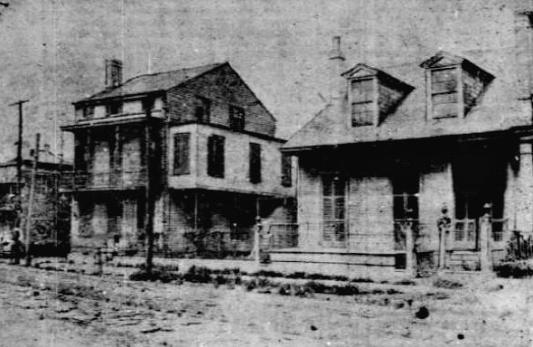
| In this 1903 photo from The Times Democrat, the building on the left is identified as the Kindergarten and Industrial School and the building on the right as the Free Clinic for children. Photo thanks to Benjamin Castrillo. |